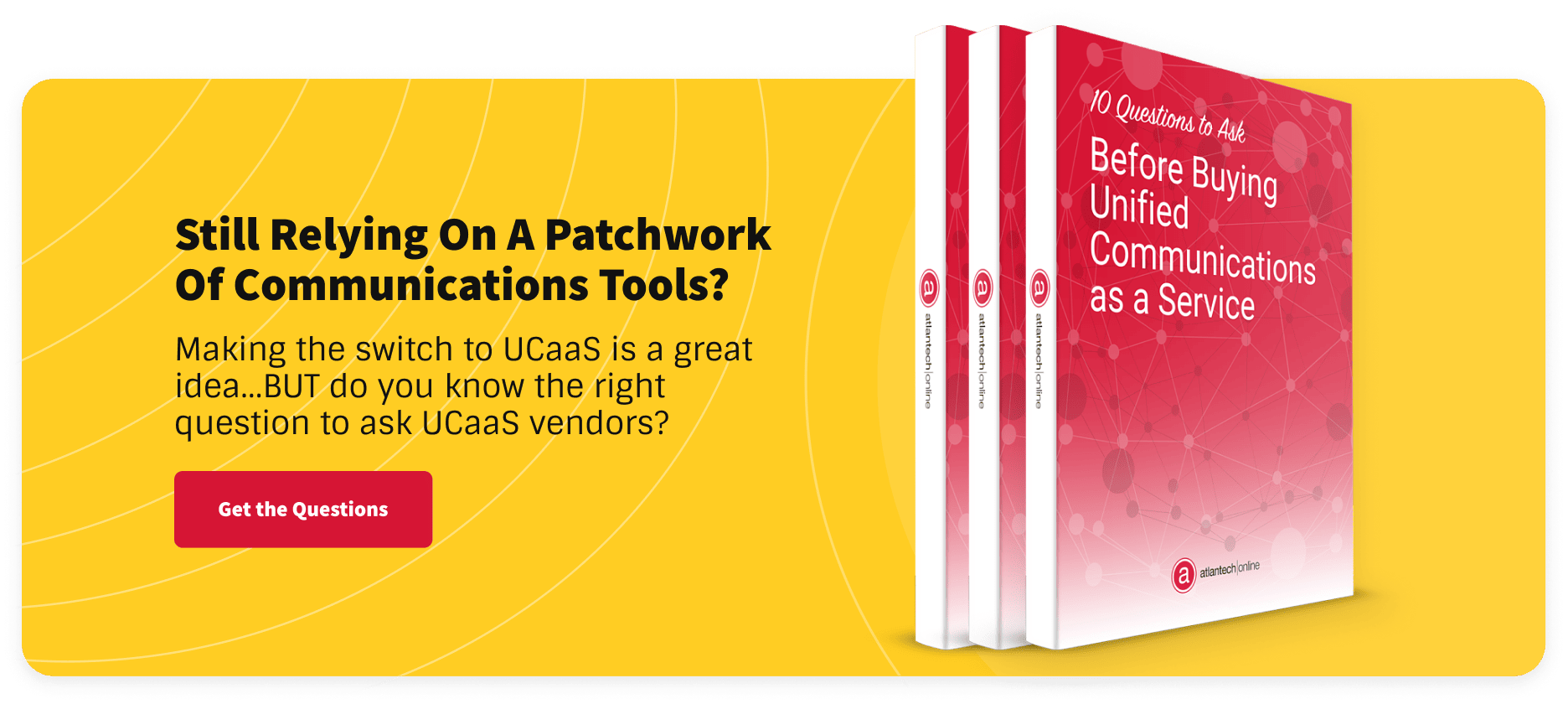Unified Communications Project Plan: 3 Steps to UCaaS Success

Organizations realize the time is right to break up with their clunky old phone systems and move to seamless, integrated Unified Communications as a Service (UCaaS) tools.
UCaaS can allow your company to operate without communication hangups, giving all of your employees access to the data and applications they need from anywhere to get their work done.
It's common for IT to feel apprehension about any technical change and the potential risk of failure. Fortunately, with the right vendor, UCaaS adoption can be truly pain-free.
Failing to understand your unified communications needs or properly train your administrators could lead to unsatisfactory results. However, an implementation plan addressing all of these risks and controls against failure can help you unlock the benefits of UCaaS without fear.
Unified Communications Project Plans: The Basics
Before we provide the details of how to migrate to unified communications, let’s first answer a key question: What are unified communications?
Unified communications are tools, processes, and services that allow you to communicate through multiple channels such as voice, messaging, meeting solutions, and more. Your unified communications project plan is the step-by-step process you will take you successfully and efficiently implement unified communications tools and structures in your organization.
Some of the benefits of implementing unified communications include:
- Increased employee productivity
- Streamlined IT operations
- Increased collaboration with remote workers
- Increased IT security
However, if you attempt to implement a solution without following a proper project plan, you may have trouble reaching a point where you can enjoy any of these benefits. Without a roadmap for success, you may waste time and resources implementing a solution that isn’t the right fit for your business.
Stage One: Planning
Assess Your Current Solution
Organizations considering a strategic transition to unified communications may have issues with their existing phone systems. You've noticed strategic issues, which could include concerns that your legacy PBX can't handle your growth plans or that your employees’ handsets are aging or are no longer supported.
However, to begin building a better UCaaS system, you also need to understand the technical aspects of your phones. How many lines do you have? What additional features, such as an automated attendant, are you already using? How does your contact center route calls? Some organizations may already have this in place. Others may need to work with their vendor on a telecommunications services audit.
Establish Your Needs
After assessing your current situation, take a moment to identify your gaps. What capabilities or functionality are you not able to enjoy with your current solution that you hope to gain from unified communications?
Additionally, establish your network and bandwidth needs at this stage. Disappointing UCaaS performance is often connected to insufficient network infrastructure. You may have call quality or latency issues if you don't have sufficient bandwidth or you're using public Internet connectivity for UCaaS.
Your vendor should help you understand your existing traffic patterns and perform a security assessment to determine how much bandwidth your new UCaaS system needs to perform securely and seamlessly.
Evaluate UCaaS Vendors
An expert vendor can work closely with your IT decision-makers to help you assess your needs for UCaaS features and help you begin planning a truly seamless implementation process.
Vendor alignment is crucial during the "vision" stage of the planning process to help you build a plan that best fits your business model, regulatory requirements, and culture.
Your vendor should help you select the right features, such as integration with back-office systems and remote management tools, and create a clear vision of what your UCaaS system will look like.
Establish Metrics
To determine whether your implementation is a success, you’ll need to establish key performance indicators (KPIs) and goal metrics in the planning stage. These metrics will help you track your progress throughout your implementation and can be used as indicators for the value of the implementation project as a whole.
Some metrics you may want to consider include session duration, error rates, CPU usage, and more.
Stage Two: Training and Adoption
Create a Statement of Work
When your organization has been guided through the UCaaS design process by your vendor, project planning will take place. A vendor should work to create a comprehensive Statement of Work for your approval, which may address each of the following factors for your new UCaaS transition:
- Project scope
- Implementation Timeline
- Number Porting
- Physical Locations for Transition
- On-Site Setup
- Employee Training
- Cost Estimates
- Testing
- Follow-Up Support
Install Fiber-Optic Internet Connectivity
The first-time installation of fiber-optic internet connectivity is a sub-project within a UCaaS adoption. Depending on your company and the type of space you are working out of, planning for fiber could require approval from landlords at multiple sites. In general, executing a successful fiber installation involves:
- Receiving signed approval and access agreements from building owners or management
- Allowing your vendor to perform an on-site survey
- Approval of an official installation plan by property management and your organization
- Physical installation of the fiber connection
- Connection of the building fiber to offices for very large or multi-tenant buildings.
Test Unified Communications On Your Data Connection
Some organizations may not experience this stage. However, organizations making major network changes such as fiber connectivity for successful unified communications implementation may experience additional testing at this stage. Pre-deployment testing can ensure a truly seamless transition and may involve your vendor performing network and application performance monitoring.
Provide Training and Guidance
There are usually at least three categories of users in most organizations; administrators, power users, and everyday users. Your training process may start with working one-on-one with IT administrators and then move to power users.
Creating internal ambassadors from each type of job function will ensure that your employees have a go-to person for questions about their roles. You may have one receptionist power user, a contact center employee power user, and someone extensively trained in conferencing features.
Address Change Management
To experience success with UCaaS migration, your employees need to be willing to use new systems and be knowledgeable on the "how-to" aspects of any changes. The statement of work should focus on change management planning, which may incorporate:
- User Types: Categories of users who require specialized training, including your IT administrators, contact center employees, and designated internal ambassadors. This should also address individual technical skills.
- Communications: How will you communicate with your users during the implementation process? Who should they direct non-urgent questions to during the transition?
- Support and Monitoring: Will your vendor provide on-site support immediately after implementation? How about long-term?
Port Numbers
Porting numbers is typically a process that requires a single business day after your old vendor has been notified and your new vendor receives the required information to perform the port.
A single-batch port is generally the recommended approach. However, in rare cases, your company's business model and needs may dictate that porting is performed in batches over several days. You will retain communications during porting, and your vendor should spend this day testing to ensure that all numbers have smoothly transferred.
Stage Three: Evaluation
Evaluate Success
Return to the KPIs you established back in the Planning stage of this project. Examine your performance and determine which of your efforts have been successful and which stand out as areas for improvement.
At this stage in the process, you will be able to optimize your implementation efforts, course-correcting where needed and doubling down on the efforts producing the greatest positive impact.
Make Necessary Adjustments
Your implementation isn’t complete once your solution is in place. Ongoing maintenance and management of your unified communications solution is a significant part of your implementation process and will dictate the overall success of your efforts.
Your IT team will need to stay up-to-date on the latest industry trends and updates related to UC. Keep an eye on changes to your vendor’s solutions and roadmaps, ensuring that you make all the necessary adjustments to keep your UCaaS solution humming.
Provide Regular Training
Just as your solution isn’t “set it and forget it,” your training efforts cannot be neglected moving forward, either. Staff may need refresher training sessions to ensure best practices are used consistently. Additionally, you will need to train staff on all new features and changes made in the step above.
One easy solution is to create an easy reference or “cheat sheet” of tips and tricks that you can simply and effectively distribute to all staff.
Cloud Communication Without Boundaries
For Montgomery College, a DC-area community college, which is among the largest in the nation, striving to provide the best communications technology to faculty meant investing in UCaaS options to scale with their needs.
CIO Carl Whitman said that leading in education tech "increasingly means putting in place the technology infrastructure to enable learning without boundaries."
This is why the organization chose Atlantech Online, powered by Broadsoft.
Scalability wasn't Montgomery College's only decision criteria. Like other educational organizations, they needed options for crisis management communications. With three distinct campus locations, they also needed advanced mobility options.
However, a key factor in their decision was the fact that Atlantech's platform is designed around comprehensive communications. It allows for the use of best-of-class PBX, instant messaging (IM), presence, HD voice and video, conferencing, file sharing, desktop sharing, and other rich communications services.
Preparing For Success with a Unified Communications Project Plan
It's common to hear about the business benefits of UCaaS, including cost savings, better-integrated data, and productivity gains. IT will occasionally hear about UCaaS adoption pitfalls, like companies who experience VoIP sound quality issues or a vendor who isn't responsive to support requests.
Carefully vetting potential vendors is important, but the planning process also affects the difference between success and failure.
Fear of a difficult, risky transition should not influence your decision to keep using aging phone systems instead of making the change to the cloud. With the right vendor, much of the heavy lifting involved with assessment and planning is taken care of.
In many cases, organizations can begin realizing serious ROI on a new UCaaS investment much quicker than anticipated. Atlantech Online, a leading vendor of truly unified communications and direct cloud connect in the Mid-Atlantic, specializes in helping prospective UCaaS users find the right vendor for their own needs, whether that's Atlantech or another organization.
To learn more about UCaaS solutions that are right for your business, check out our free resource, 10 Questions To Ask Before You buy Unified Communications as a Service.


